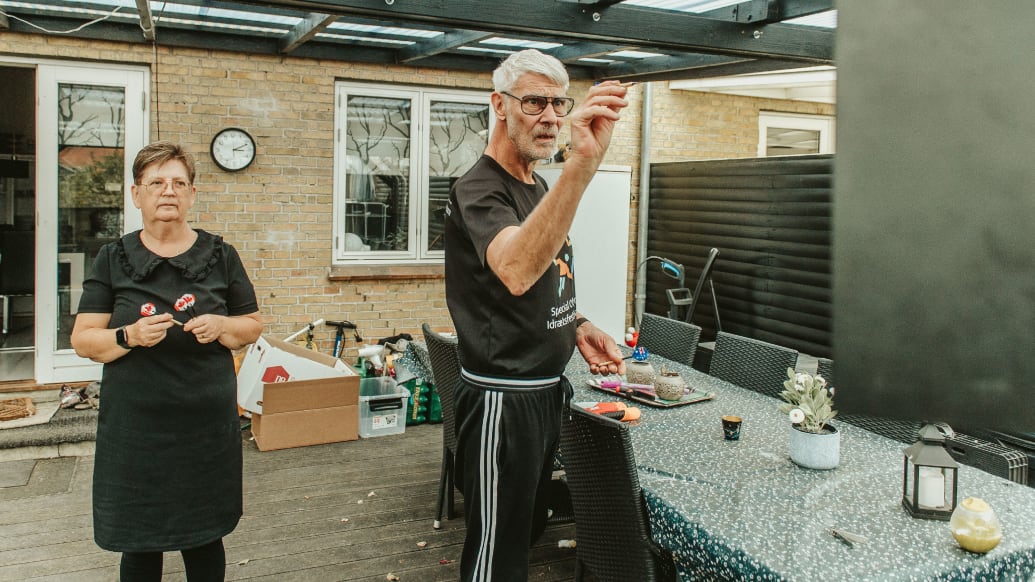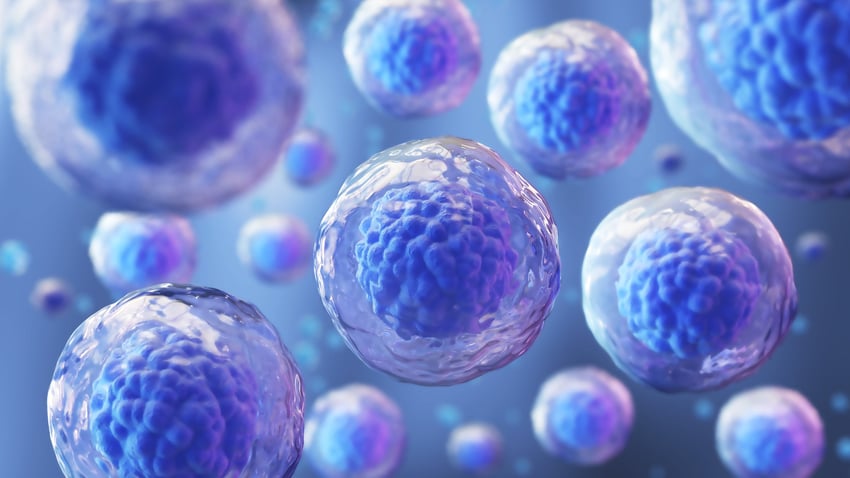Fingers Crossed. If it works, it will forever turn the tide in our fight against the disease.
by Sebastian Skov Andersen – The Daily Beast – Link to article
Last year, Jette Oppelstrup, 49, invested in a bathroom on the ground floor of her townhouse in Herlev, a suburb of Copenhagen. In the bottom-left corner of the mirror above her sink in the new bathroom are two stickers that read: “FUCK PARKINSON, NEVER GIVE UP”.
Oppelstrup was diagnosed with Parkinson’s disease in 2017. The disease rarely strikes people under the age of 60, and is best known for afflicting people with visible tremors on their hands and slowing their movement. In the future, she may not be able to walk upstairs to her old bathroom as often as nature calls.
But for people living with Parkinson’s today, contrary to just a decade ago, the phrase “never give up” is no longer just a motivational saying. A new Parkinson’s treatment that uses stem cells to artificially create new dopamine-producing nerve cells is expected to enter clinical trials on human patients later this year. Because of the long course of Parkinson’s, many patients who receive a diagnosis today may live long enough to be eligible for this kind of treatment and find their lives spared from the harsh advanced stages of the disease—and perhaps see their motor function restored.
That is, of course, if the treatment is successful.

The mirror in Jette Oppelstrup’s bathroom that reads “FUCK PARKINSON NEVER GIVE UP.” – Photo: Sebastian Skov Andersen
Nearly one million people are living with Parkinson’s disease in the United States alone, according to the Parkinson’s Foundation. About 60,000 people are diagnosed with Parkinson’s each year, and that number is expected to rise to 1.2 million by the end of this decade. It is the fastest rising neurological disorder in the world, with the global number of diagnosed people doubling from 3 to 6 million people between 1990 and 2015. If this development continues, the number of cases will again have doubled by 2040.
“If the rate at which Parkinson’s growth continues, we’re going to outgrow the capacity to be able to handle all of the consequences of letting a chronic neurodegenerative disease go unchecked,” Michael S. Okun, a neurologist at the University of Florida and one of the world’s leading Parkinson’s scientists, told The Daily Beast.
After decades of research, what we know so far is that Parkinson’s is caused when dopamine-producing nerve cells in the brain die too fast. Often called the “happy hormone”, dopamine is critical for relaying signals from the brain that give orders of movement to different body parts. A dearth of dopamine will cause tremors and slowed movement. These symptoms only worsen over time, and make it extremely difficult to do even the simplest activities in the late stages of the illness.
And Parkinson’s can lead to cognitive effects as well, such as short-term memory loss, difficulties with staying focused, and challenges with impulse control.
For all these reasons, “it’s hard to truly have faith that a treatment will be developed in time,” Oppelstrup told The Daily Beast. “But I’ll be the first in line for the trials. I just gotta figure out where to sign up.”

Jette Oppelstrup was diagnosed with Parkinson’s in 2017. She is skeptical any treatment will be ready in time in her lifetime, but but says she’ll be first in line for treatment.
The new trials are the culmination of more than 10 years’ work by scientists at Lund University in Sweden and the University of Copenhagen in Denmark, along with support by the Danish pharmaceutical giant Novo Nordisk. It raises big hopes that we might finally have something to transform the lives of millions who are living with Parkinson’s.
The treatment itself works by taking stem cells from surplus fertilized eggs from in vitro fertilization (IVF) clinics. These cells are derived from the earliest stages of fetal development, which means they are able to be grown into any other type of cell found in the body. That includes the dopamine-producing nerve cells that are lost in Parkinson’s disease.
“What we then do is add a series of very specific proteins—so-called growth factors—so that the cells develop into the necessary dopamine-producing nerve cells in the petri dish,” Agnete Kirkeby, a University of Copenhagen neuroscientist who’s helped pioneer the new treatment, told The Daily Beast. “Then the cells are surgically inserted into the brain using a special type of needle, and will hopefully produce dopamine in place of the patient’s dead nerve cells.”
According to Kirkeby, the team has been testing this therapy on animal models since 2012. The implanted cells have been shown to survive transplantation in rats and communicate with the body’s other cells to restore dopamine production—and by extension, motor function.
The process of developing such a treatment is long-winded because the amount and sequence of growth factors used must be incredibly precise in order to develop the stem cells into nerve cells. Finding the correct combination of growth factors comes down to an informed edition of trial-and-error.
Another treatment known as deep brain stimulation, where implants are used to deliver direct electrical stimulation to certain parts of the brain, has already been successful in delaying or alleviating the physical symptoms of Parkinson’s by up to several years. Since neurosurgeons have already established a safe surgical method for implanting these electrodes, they can use a similar method for safely cutting into the brain and delivering the stem cells, explained Kirkeby.
“We hope to begin the trials this year, and if they go well, the stem cell treatment can hopefully hit the shelves and be used to treat Parkinson’s patients as soon as eight to ten years from now,” she said. If the treatment is approved after the first trials, the plan is for Novo Nordisk to move the treatment into larger-scale trials.
It’s not simply that the treatment could provide relief to millions of people around the world. Because Parkinson’s disease has such a long natural history and patients may be severely debilitated for years and years, being a caregiver is a full-time job. Many may need to take time off work to care for their relatives, and the physical toll the care takes on their bodies may lead to future health problems of their own.
“We are facing an issue that if we don’t deal with it, we are going to see catastrophic consequences. Not just from patient-suffering, but economic consequences and the ability of our health-care systems to stand up,” said Okun.
Still, although there’s quite a bit of hope about what the new stem cell treatment could do for patients and their families alike, there’s a history of new therapies petering out during rigorous testing.
“It happens very rarely that we actually cure an illness,” Ray Dorsey, a neurologist at the University of Rochester Medical Center, told The Daily Beast. “A lot more often we find a way to prevent them. Think about what it takes to cure someone with Parkinson’s after half of their nerve cells have died. I just think we need to take a cool, rational look at this and say that that’s really hard to do.”
And while we have a clear picture of the dopamine connection, we have very little understanding about exactly why nerve cells will start to produce less dopamine in certain people. Age is obviously a big correlation, and some research has pointed to associations with the use of certain pesticides and metals due to the disproportionately high number of rural inhabitants who come down with Parkinson’s. Some scientists speculate that if we lived long enough, all humans would eventually develop Parkinson’s since cells begin to die due to old age.
Karin Christiansen, 57, and her husband Keld Hansen, 65, live in Odense, Denmark’s third-largest city. In 2018, Karin was diagnosed with Parkinson’s disease after several years of living with symptoms, including strong pain in the right leg and having a hard time keeping balance.

Karin Christiansen and her husband Keld Hansen.
“The worst part is the fear of disappearing in my mind,” Christiansen told The Daily Beast, referring to the risk of developing dementia as a long-term symptom of Parkinson’s. Even though she is a participant in closed trials for another new experimental treatment that has helped significantly to alleviate her pain and regain control over her bodily functions, she has a hard time believing that any treatment could “save” her in time—not even stem cells.
“I’m scared that once you’ve been sick, it’s hard to go back to normal again,” added Hansen. “It’s her brain that’s being destroyed, and I’m not sure that’s possible to restore.”
So even though the rats may soon be swapped with humans, and the stem cell treatment may be right around the corner, Karin tries not to pay too much attention to it. Getting her hopes up, in all likelihood, would just end in disappointment, she said.
Instead, she is not so much looking forward to what treatments like this might do for her—but rather what they might do for the next generations.
“It’s probably mostly the people who are diagnosed in the future who will be lucky enough to benefit from it,” said Christiansen.




